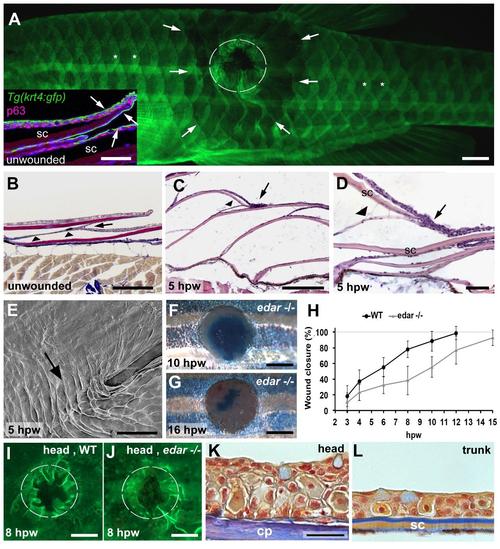Fig. S4
- ID
- ZDB-FIG-160714-25
- Publication
- Richardson et al., 2016 - Re-epithelialization of cutaneous wounds in adult zebrafish uses a combination of mechanisms at play during wound closure in embryonic and adult mammals
- Other Figures
- All Figure Page
- Back to All Figure Page
|
Re-epithelialization uses epidermal inter-scale reservoirs. (A) Overview of a Tg(krt4:gfp) wounded fish at 5 hpw. In unwounded regions, the posterior tip of the scales exhibit stronger GFP signal (marked by asterisks) due to overlapping GFP-positive cells wrapping the scale tip (arrowed in immunofluorescence of sections in inset). In a large area around the wound, the epidermis appears less GFP-positive (arrows depict the outer margin). The circle marks the approximate extent of the wound. (B-D) Histological analysis of the unwounded skin (B) and region adjacent to the wound (C,D), demonstrating the bridging of the epidermis from one scale to the next (indicated by arrows). Panel (D) shows higher magnification of such a ?bridge?, with epidermal cells on the apical surface of one scale crossing onto the apical surface of the adjacent scale with no wrapping of the posterior tip of the scale. The only cellular structure seen beneath the scale is the dermal tether (indicated by arrowheads). (E) SEM micrograph of epidermal surface adjacent to the wound. The bridging epidermis between two adjacent scales is indicated by the arrow. (F,G) Methylene blue analysis of full thickness wounds to the flank of edar-/- fish indicates that these wounds re-epithelialize slower than in wild type and are not fully closed at 16 hpw. (H) Graphical illustration of the kinetics of wound closure of edar-/- and wild-type control fish, determined via the methylene blue penetration assay at indicated time points after wounding. Mean values and standard deviations are indicated. (I,J) Live fluorescent images of Tg(krt4:GFP) wild-type (I) and edar-/- (J) fish after introduction of full-thickness wounds on the forehead; 8 hpw; anterior to the left; wound encircled. Head wounds of wild-type fish (I: 63%; average: 65▒14.1%; n=11) and edar mutants (J: 63%; average: 65▒14.1%; n=9) display similar degrees of closure. However, both are less closed than equally-sized 8 hpw wounds in the flank of wild-type fish (78▒10.6%; 6 fish; panel H), and more closed than equally-sized 8 hpw in the flank of edar mutants (38▒18.0%; 6 fish; panel H). (K,L) AFOG staining of longitudinal section through head (K) and trunk (L) of 1-year old unwounded wild-type fish; anterior to the left. The epidermis on the forehead consists of 6-8 keratinocyte layers and is approximately 300 Ám thick, the epidermis on the scales of the trunk consists of 3-4 keratinocyte layers and is approximately 150 Ám thick. Since the head epidermis sits almost directly on the bony calvarial plates of the skull (K), reduced laser settings had to be used for wounding (specified in Materials & Methods) to avoid damage to the skull. Abbreviations: cp, calvarial plate of skull; sc, scale. Scale bars: A,F,G,I,J = 1mm; D,E, inset in A = 50 Ám; B,C,K,L = 200 Ám. Due to the different laser settings during wound introduction, direct comparisons of wild-type wounds in the (scale-bearing) trunk and the (scale-free) head (H,I) with respect to the impact of inter-scale pockets have to be taken with caution. The same applies to direct comparisons of trunk wounds in (scale-bearing) wild-type fish and (scale-free) edar mutants (H), as during scale placode formation, edar mutants also present defects in epidermal cells themselves (Harris et al., 2008). Thus, the lack of inter-scale reservoirs may not be the only cause of the wound closure defect. However, it is noteworthy that wounds in scale-free head regions lacking the inter-scale pockets close more slowly than wild-type trunk wounds (H,I), although the higher thickness of the head epidermis (K,L) should have a positive effect on re-epithelialization, as it contains more keratinocytes that could be recruited during wound re-epithelialization. Consistent with the latter notion, edar mutants, which lack scales and inter-scale pockets both in head and trunk, head wounds close faster than trunk wounds (F,J). Together, this points to a more efficient recruitment of keratinocytes from inter-scale pockets than from an accordingly thicker epidermis. Furthermore, the unaltered closure rates of head wounds of edar mutants compared to wild-type siblings (I,J) strongly argues against a general negative effect of the edar mutation on the re-epithelializing capabilities of keratinocytes, suggesting that the reduced closure rates of trunk wounds in edar mutants compared to wild-type fish (H) are indeed primarily caused by the absence of the inter-scale pockets. |

